How Big of a Hd Can You Read With a Galaxy S8 Plus
Samsung Galaxy S8+ (Plus, SM-G955F) Smartphone Review
Galactic overachiever. Samsung does not make any compromises for its flagship smartphone Galaxy S8+ (Plus) and equips information technology with a lot of high-end features. You likewise get a great display with a new aspect ratio and the design is convenient also. There is not much criticism for the compact phablet from Korea.
Update: A new firmware with improved reliability for the Bluetooth chip and the SD card reader has been released.
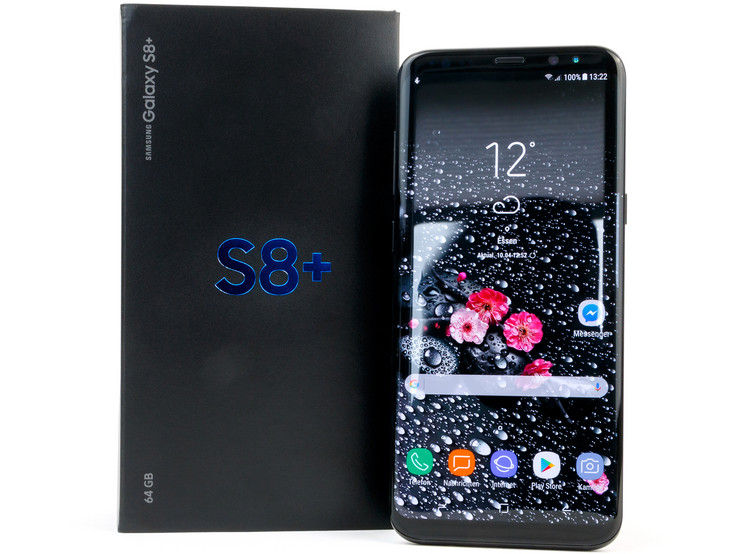
For the original High german review, see here.
The Samsung Galaxy S8+ (Plus) is the successor to the Galaxy S7 Edge, which was the best smartphone nosotros reviewed last year. The new model follows the footsteps of the previous model and sets new benchmarks.
The Galaxy S8 Plus is the larger smartphone from the S8-series with a panel diagonal size of 6.2-inches. This sounds enormous, especially with the 5.5-inch screen of the Galaxy S7 Edge in mind. All the same, the size is a issue of the new aspect ratio, then the smartphones are getting longer and offer more than visible screen content, but they are nevertheless easy to concord thanks to the narrow construction. The small-scale Milky way S8 has a five.8-inch screen, a smaller battery (3000 mAh) and is 100 Euros (~$107) less expensive. Yet, the differences stop in that location.
Our test model is powered by the new Samsung Exynos 8895 SoC, which is already manufactured in a ten-nm process. You as well go iv GB RAM and 64 GB internal UFS ii.1 storage. The latter tin can be expanded by up to 256 GB via microSD. The Plus version also features a 3500 mAh battery and is once again protected against water and dust co-ordinate to IP68. Samsung now also uses a USB Type-C port and equips the smartphone with numerous sensors. A new feature is the Iris scanner, which we already know from the Galaxy Notation 7. Other small highlights include Gigabit LTE besides equally Bluetooth 5.0, and the Wi-Fi performance is supposed to exist much better as well. Samsung's ain voice assistant Bixby is only available for Korean and English language customers correct at present.
Samsung's smartphone is aggressive and a big claiming for the rivals. The comparison devices include the long-term competitors Apple tree iPhone 7 Plus, Sony Xperia XZ, HTC U Ultra, Huawei Mate 9, LG G6, Lenovo Moto Z and the Google Pixel XL.
Update 6/12/2017: Samsung has released a firmware update for the Galaxy S8+. Details can be found in the section on firmware updates below.
Display
half dozen.20 inch 2.06:1, 2960 ten 1440 pixel 531 PPI, capacitive touchscreen, ten multi-bear upon points, Infinity Display, Corning Gorilla Glas 5, Super AMOLED, Mobile Premium HDR, glossy: yes
Storage
64 GB UFS 2.1 Flash, 64 GB
, 52.3 GB free
Weight
172 g ( = 6.07 oz / 0.38 pounds), Power Supply: 62 g ( = 2.19 oz / 0.14 pounds)
Notation: The manufacturer may apply components from unlike suppliers including brandish panels, drives or memory sticks with similar specifications.
The rounded display edges are at present standard for the new S models, but they are not as steep as on the Galaxy S7 Border. The Milky way S8 Plus about looks frame-less compared to the previous model, because the panel drinking glass now near sits flush with the aluminum frame. The bezels at the top and bottom are also much slimmer than earlier, so you become the impression that you just hold a display at offset. Samsung actually pulled off a smashing design with an excellent screen-to-trunk ratio.
The tactile feeling of the Samsung Milky way S8+ is besides peachy, but it still appears very sturdy. Both the front and rear are completely made of Corning Gorilla Drinking glass 5, which attracts fingerprints, but it is like shooting fish in a barrel to make clean. Information technology will move on a slightly angled surface when you put it on the screen. This is prevented by a small-scale frame effectually the camera on the rear, which is otherwise affluent with the instance. The metal frame makes the case very sturdy, and it supports the noble design of the S8+ in combination with the glass elements. The smartphone is also very resistant against twisting attempts, and it requires some forcefulness to provoke creaking. There is no criticism for the gaps, either.
The device is one time again certified according to the IP68 standard and therefore protected against water and dust. The bombardment is integrated and cannot exist removed by the user. The card tray is made of plastic and can suit a Nano-SIM as well as a microSD-card. There is no dual-SIM model.
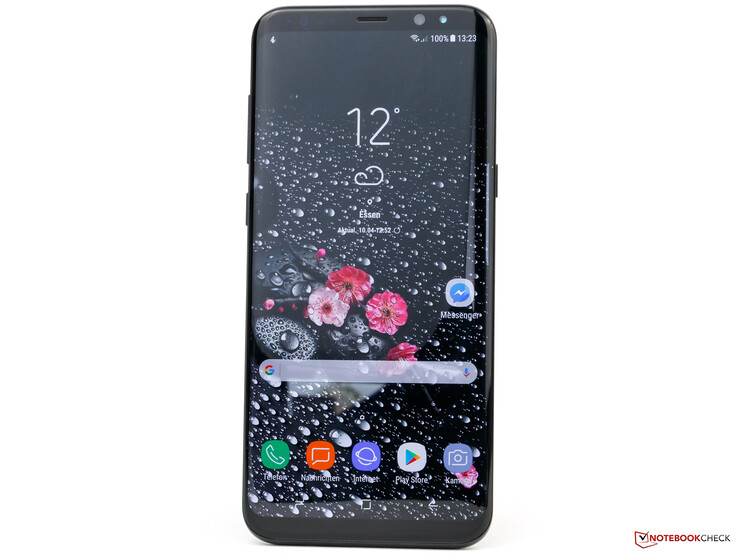
❌
It is probably easier to listing what features the Samsung Galaxy S8+ (Plus) does not include at this bespeak. Samsung in one case over again waives an infrared transmitter to control your devices at domicile. You cannot apply information technology as an FM radio, either, only at that place is withal the chance this characteristic will be fabricated available via update – similar to the predecessor.
You lot can aggrandize the storage with an optional microSD-carte. It supports all common SDXC modules with a storage chapters of up to ii TB, merely the maximum size available right now is 256 GB. It is not possible to format the microSD-carte as internal storage or transfer apps to the bill of fare due to the functioning differences betwixt the internal and external storage.
The USB port has a modern Blazon-C connector and supports the USB standard 3.one (Gen.i) every bit well as OTG, so you tin can attach peripherals or storage devices via adapter. It is also possible to charge other devices with the S8+ and the port supports video output via DisplayPort ane.2.
The sensor equipment is more than comprehensive and includes a fingerprint scanner as well as an Iris scanner among others. You also get a middle-rate monitor at the dorsum. Besides NFC, you lot too go Bluetooth v.0. The latter is brand-new and was heavily improved in terms of range, transfer rates every bit well as power consumption. Samsung does not advertise the form of the module, and then we cannot give you any specifics. However, it is now possible to bulldoze two Bluetooth speakers at the same fourth dimension. The aptX codec ensures proficient sound, but the newer aptX Hard disk is non supported.
Samsung ships the Milky way S8+ with Google'south Android vii.0 Nougat in combination with Samsung's UI 8.1. This is a visible evolution compared to the previous Grace UI. The app drawer was waived completely, just yous tin can now attain an overview for all apps with a vertical stripe across the home screen. Familiar functions like the Border bar or the game launcher are one time over again included, just like Samsung's own app store. Apps from Microsoft and Facebook are also preinstalled; they cannot exist removed completely, but only deactivated.
The security patch level (March i, 2017) is upwardly to date at the time of the review. It remains to exist seen whether Samsung will provide frequent updates.
This section is meant to keep y'all upward to appointment near firmware updates released past Samsung for the Galaxy S8+.
Update 6/12/2017: Samsung has released a new firmware, NRD90M.955FXXU1AQEB, promising improvements in Bluetooth and SD menu reader stability and reliability. In add-on, Google's security patches have been brought upwardly to date: patch level 5/i/17.
The Samsung Galaxy S8+ leaves a skillful impression in terms of connectivity. The Wi-Fi module of the smartphone supports the IEEE 802.eleven standards a/b/thousand/due north/ac in two.4 every bit well as 5 GHz networks, which is common for a device in this price range. Information technology too supports VHT80 MU-MIMO as well as 1024 QAM (ten-bit square amplitude manipulation). The latter in particular is supposed to improve the transfer rates and the stability.
The Galaxy S8+ actually reaches very high transfer rates for a smartphone in the test with our reference router Linksys EA8500. The values are very good when the device receives data, but the Google Pixel XL and the iPhone seven are even faster in this respect. The highlight is the transport functioning, considering the Galaxy S8+ manages a great effect of 656 Mbps and sits at the meridian of the ranking for smartphones. The dampening is excellent in close proximity to the router at -43 dBM (2.4 GHz) and -30 dBM (five GHz). The dampening is stronger when we move away from the router and is but -71 up to -79 dBM (depending on the orientation of the smartphone) at a distance of 12 meters (and 1 internal wall). It even drops to -86 dBM when the smartphone is lying flat on a solid surface. The performance is all the same sufficient for the streaming of HD videos.
Notwithstanding, our test model did have issues with 5 GHz networks from time to time. We did not manage to plant a stable connection with a Devolo dLAN 1200+ Wi-Fi air-conditioning. The network was recognized and the connection was established simply immediately dropped, which started a reconnecting process. We did not have these bug with the EA8500, so there does not seem to be a general problem with this frequency.
The Samsung Galaxy S8 Plus tin access mobile Internet via quad-band GSM, six 3G bands or via modern Gigabit LTE (downstream: up to 1 Gbps, upstream: upwards to 150 Mbps). Samsung unfortunately limits the device to a specific region and the test model merely supports 11 LTE bands. This is completely sufficient for Europe, but we would have liked to see a global coverage considering the loftier price.
| Networking | |
| iperf3 Customer (transmit) 1 m 4M x10 Netgear AX12 | |
| Samsung Galaxy S8 Plus | |
| Apple iPhone 7 (Klaus I211) | |
| Google Pixel Forty 2016 | |
| Samsung Milky way S7 Edge | |
| LG G6 | |
| Huawei Mate 9 | |
| iperf3 Client (receive) 1 chiliad 4M x10 Netgear AX12 | |
| Apple tree iPhone 7 (Klaus I211) | |
| Google Pixel XL 2016 | |
| Samsung Galaxy S8 Plus | |
| LG G6 | |
| Samsung Galaxy S7 Edge | |
| Huawei Mate 9 | |
The Samsung Galaxy S8 Plus can locate its position via satellite networks (GNSS) GPS, Glonass, BeiDou, and Galileo. It is dainty that all GNSS are actually recognized and the location is very quick both outdoors also every bit indoors. The accurateness was right abroad down to four meters outside the building and then leveled off at ii meters – excellent.
We besides compare the operation with the Garmin Edge 500 on a brusk bicycle ride. The difference between the two devices is just 10 meters after the 12 km-long track. A corking issue for the Galaxy S8 Plus, which also holds up in a detailed analysis, considering nosotros tin can only encounter minor deviations and the smartphone is sometimes even more accurate than the bicycle navigation system. We did non notice any limitations for navigation in a motorcar, either.
The phone app of the Samsung smartphone is similar to the default Google app and the design was just slightly customized. The handling should not be a problem for any user.
Nosotros are convinced by the voice quality. There are no problems when we apply the smartphone at the ear, because both sides can enjoy clear vocalism quality. The speaker is also usable in quiet environments. We heard our telephone call partner very well, which is as well the example for the Galaxy user, fifty-fifty though the vox echoes too much. The provided AKG headphones as well left a skilful impression. Our call partner sounded a flake dull due to the emphasis on low frequencies, but in that location are otherwise no problems. The microphone of the headset in detail works well indoors, merely it cannot actually filter wind sounds outdoors. The noise suppression of the Galaxy S8 Plus likewise works well, but loud voices are a problem.
Nosotros also noticed that the Galaxy S8 Plus tends to produce some static in close proximity to DECT-capable devices. The electromagnetic shielding could be better.

Samsung improved the front end camera of the Galaxy S8 Plus. It now has an 8 MP sensor with autofocus equally well every bit an aperture of f/i.7, so it captures a lot of light. Videos can be recorded in Full Hard disk drive (1920x1080 pixels). The preloaded beauty filter offers numerous settings. Besides the skin color and the shape of the face, you can also modify the size of the eyes. There are many other filters or you can just download them. Samsung also preinstalls 3D animations, which adjust to the picture and some of them are animated. We like the results and they also work well in environments with low lighting.
Bixby Vision is another new feature, which can easily exist activated by a small icon. The camera is supposed to analyze objects and text, and then y'all can edit them. It is fifty-fifty supposed to collect data almost the product via Internet or translate texts. Unfortunately, this did non work very well. The smartphone was not able to give usa shopping recommendations, and Bixby Vision did non even recognize the product information for the Galaxy S8+. Texts had many gaps, so translations were useless. The idea itself is very good, but Bixby Vision however needs improvements.
The specs of the principal camera did not change compared to the previous model. It is yet a 12.two MP dual-pixel sensor with a pixel size of one.40 μm. The aperture did not alter at f/1.7, either, and you also get an optical image stabilizer (OIS). Samsung supposedly improved the software. The bodily pictures look great, just similar they did on the Galaxy S7 Edge. The results are fifty-fifty a little brighter in low-light situations and the edges are a bit sharper than before. However, these differences are only noticeable when yous enlarge the pictures.
You can besides use a manual mode once more with settings for the white residuum, lite sensitivity (ISO fifty - 800), exposure (1/24000 - 10s) and arrange the focus manually. Information technology is also possible to shop RAW pictures in the Pro mode, and so Samsung did non alter a lot. Even the bug are still there, considering the Live-View mode only works upward to an exposure of one second, before the view and the result do not match anymore.
The video mode is too identical to the Galaxy S7 models, which ways you lot can record at 3840x2160 pixels (Ultra HD @thirty fps, up to 10 minutes at one time). The quality is nonetheless very expert, just Samsung unfortunately missed the opportunity to better the functionality. Great features similar the automated chase role of the auto-focus and HDR are withal not available in Ultra Hd or at 60 frames per second. A await at the spec sheet of the Exynos 8895 shows that the ISP of the SoC tin can handle much more, including Ultra Hard disk at up to 120 fps. This means Samsung is still number one in general, just it cannot increment the technological advantage.
Prototype Comparison
Choose a scene and navigate within the beginning image. One click changes the position on touchscreens. Ane click on the zoomed-in image opens the original in a new window. The first epitome shows the scaled photograph of the test device.
Scene 1Scene 2Scene 3
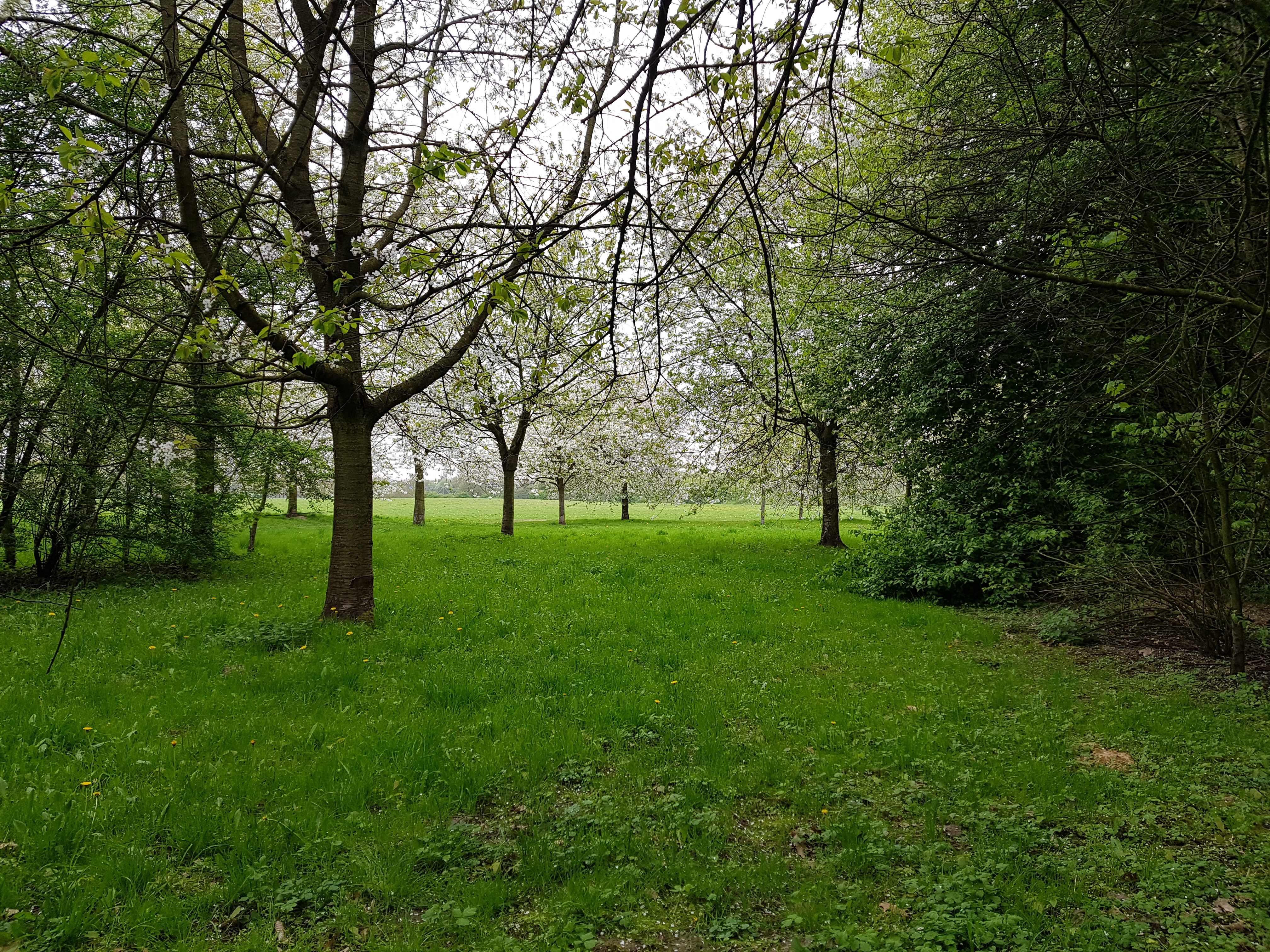
click to load images

click to load images
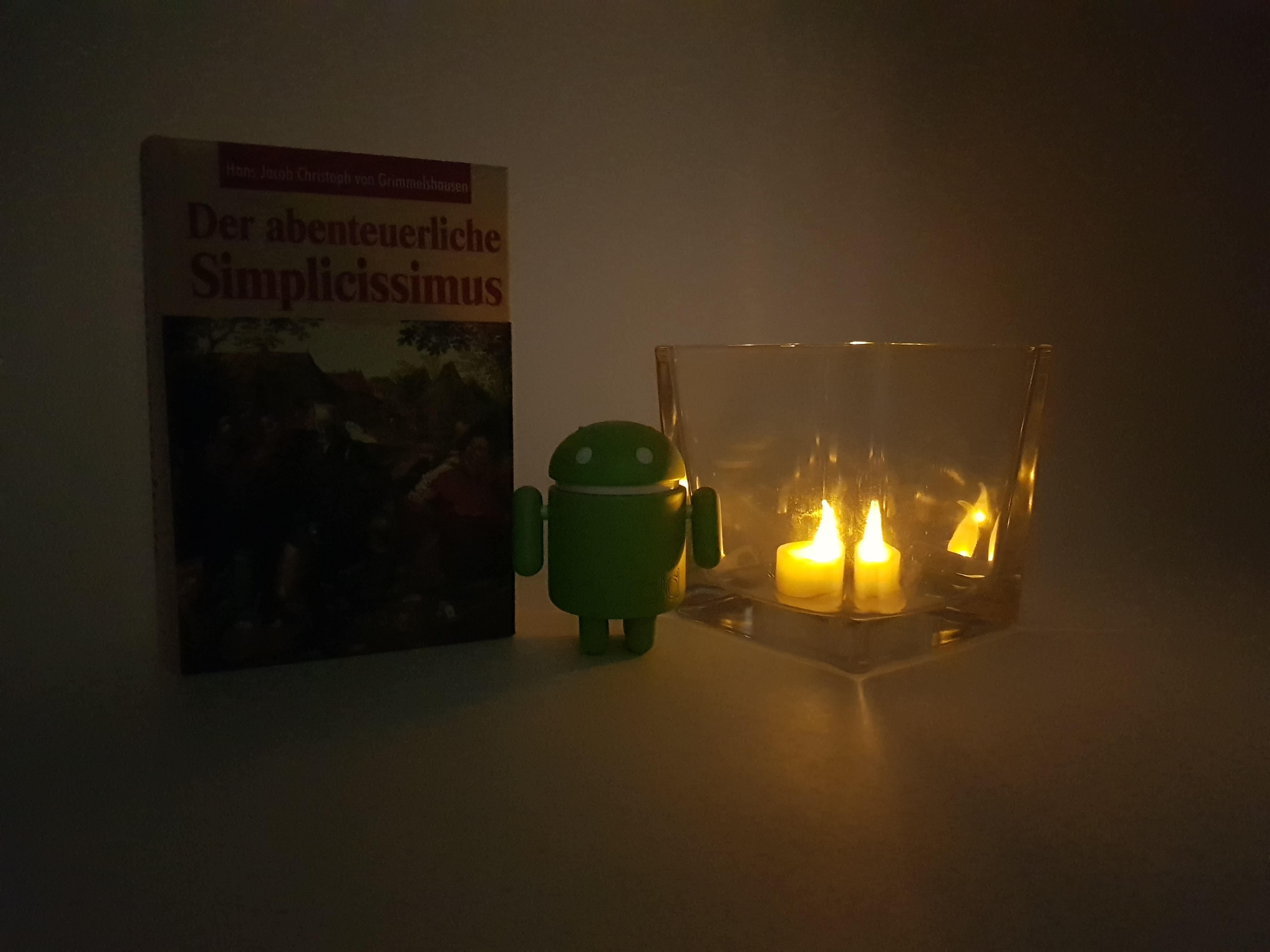
click to load images
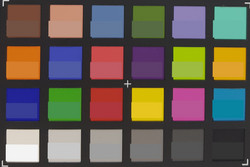
We also checked the photographic camera of the Samsung Milky way S8 Plus nether controlled lighting conditions. The results were not altered afterwards. The film of the 10-Rite ColorChecker PassPort shows rich colors, but they are still comparatively natural. The sensor as well uses a pretty warm white balance. Dark-green and carmine colors are likewise more saturated than others.
The Galaxy S8 Plus as well leaves a positive impression on the test nautical chart. The moving picture is very abrupt in the center, which hardly suffers towards the edges. The color transitions and the signs on the colored surfaces are also very well captured.
The box of the Samsung Milky way S8 Plus (black) includes a black modular power adapter (9.0 V, 1.67 A; 5.0 5, 2.0 A), a corresponding USB cablevision (Blazon-A to Type-C), two OTG adapters (Type-C to Blazon-A and Type-C to Micro-USB), a SIM tool, an AKG in-ear headset with different-sized tips besides as several leaflets regarding security, warranty, and a quick-get-go guide.
Samsung also offers numerous accessories for its flagship model in its online store. Besides the usual covers (most of them are already familiar from the predecessor), you too get external batteries as well every bit inductive quick chargers. There is now also a USB Type-C to HDMI adapter, which is supposed to manage Ultra Hard disk. An optional Starter Kit includes an additional battery (quick-accuse capable), a protective screen cover every bit well equally a transparent cover. Samsung also launches DeX right for the launch of the Galaxy S8 models, which allows using the smartphone as a reckoner. The principle is similar to Microsoft'due south Continuum, but it shows Android as a desktop instead of Windows.
Samsung grants a two-year warranty for its product. The provided accompaniment is only covered by half-dozen months; the battery for 12 months.
You lot can purchase Samsung'southward Mobile intendance package when yous buy the smartphone, which costs another 119 Euros (~$127). Information technology covers damages like cleaved displays, fluid damages or bombardment defects for 24 months. Customers have to pay an additional payment of 10% of the retail toll. I interesting aspect is that the warranty conditions state liquid damages are not covered:
The following points are now covered by the warranty: […] The product was exposed to whatever kind of liquids/chemicals and/or extreme temperatures, moisture or humidity.
This is a bit irritating considering the advertised IP68 certification against dust and water, and the client has to rely on Samsung's goodwill in such a case.
Delight see our Guarantees, Return policies and Warranties FAQ for land-specific information.

The capacitive touchscreen of the Samsung Galaxy S8 Plus is protected by Corning Gorilla Glass 5 and provides very proficient gliding capabilities. At that place are no issues with the accuracy and the responsiveness, either. Samsung uses its own keyboard layout, which has a simple design, makes word predictions and supports swipe gestures. It is too possible to install other layouts from the Google Play Store.
The concrete smartphone buttons are well-built and integrated. You lot get the power push button, the volume rocker, and a button for Bixby. The latter also launches an overview with upcoming events, atmospheric condition data, news, and many more than when you hit it while the smartphone is locked.
The home button from the previous model is gone. Samsung at present placed information technology underneath the display instead; information technology is a pressure-sensitive sensor. The other ii Google buttons are at present onscreen buttons. This works very well in practise. The dwelling button is missing, and then the fingerprint scanner moved to the back and now even supports a swiping gesture to launch the notification center. Samsung plainly copied this from Huawei models like the Mate ix, even though the functionality is not as comprehensive. The fingerprint scanner itself is quick and reliable, but we exercise not really like the position on the Milky way S8+. Nosotros often dislocated the fingerprint scanner with the camera lens, and the sensor is also tricky to reach depending on the orientation of the smartphone. The same applies for the heart-rate monitor, which can likewise be used to trigger the front camera. It is unfortunately almost impossible to find with the finger.
The Samsung Galaxy S8 Plus as well includes other security features besides the fingerprint scanner. The Iris scanner was already used for the Note 7 and is as well reliable, but information technology unfortunately requires a 2d to unlock the device. The facial recognition is much faster, only less secure, and Samsung notes this aspect during the setup. Our colleagues from Heise were able to unlock the smartphone with a moving-picture show, so we would not recommend using this feature.
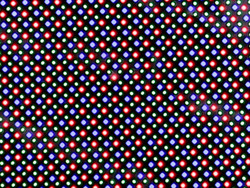
The Samsung Galaxy S8 Plus has a half dozen.2-inch Super-AMOLED console, which is called Infinity display by the manufacturer. It has a resolution of 2960x1440 pixels and a pixel density of 531 PPI, so content is razor-sharp. Likewise the curved display edges at the two long edges, the corners are likewise round this time, then the diagonal size drops to half-dozen.1-inches depending how you measure out information technology. The display size itself grows thanks to the new aspect ratio of 2.06:1 (xviii.5:9), just the console surface is smaller compared to the popular xvi:nine ratio. This is too shown by the post-obit tabular array. The display is even so huge, even though the Huawei Mate 9 appears bulkier (5.nine-inch, 16:nine).
| Smartphone | Galaxy S8+ | 6.two inches (16:ix) | Galaxy S7 Border | LG G6 | Huawei Mate nine | iPhone 7 Plus | Phab 2 Pro |
|---|---|---|---|---|---|---|---|
| Panel surface | 97.56 cm² | 105.97 cm² | 83.39 cm² | 86.81 cm² | 95.96 cm² | 83.39 cm² | 112.92 cm² |
Yous can only utilise the full luminance of the Galaxy S8+ with the activated brightness sensor; we can mensurate up to 358 nits in the center on a pure white background with the transmission control. If the sensor, which adjusts the luminance quickly, is working, nosotros tin can mensurate upward to 577 nits in the aforementioned scenario. The more than realistic APL50 measurement with an even distribution of brilliant and dark content results in almost 800 nits. This is already an enormous result; our colleagues from DisplayMate fifty-fifty measured up to chiliad nits.
The brightness distribution is very even at 93% and the panel can evidence consummate black due to the OLED technology, and then the contrast ratio is theoretically infinite. An heart-protecting blue-lite filter is also bachelor, only like the Always-On display function from the predecessor.
The panel supports HDR content, which is already provided by streaming services similar Amazon and Netflix. It promises higher dynamic range and richer colors.
Our examination model of the Samsung Milky way S8+ was adjusted to a lower screen resolution of 2220x1080 pixels by default. This saves ability, but y'all should cheque the settings when y'all desire to enjoy the all-time picture quality of the first-class screen.
| 539 cd/m² | 561 cd/thou² | 571 cd/chiliad² | ||
| 555 cd/one thousand² | 560 cd/thou² | 569 cd/thousand² | ||
| 561 cd/k² | 561 cd/m² | 577 cd/m² | ||
Distribution of brightness
Infinity Display, Corning Gorilla Glas 5
X-Rite i1Pro 2
Maximum: 577 cd/k² (Nits) Average: 561.6 cd/m² Minimum: i.72 cd/m²
Brightness Distribution: 93 %
Heart on Battery: 560 cd/g²
Contrast: ∞:one (Blackness: 0 cd/one thousand²)
ΔE Color 1.7 | 0.59-29.43 Ø5.iv
ΔE Greyscale 1.6 | 0.64-98 Ø5.7
99.87% sRGB (Argyll one.6.3 3D)
81.57% AdobeRGB 1998 (Argyll 1.6.three 3D)
92.31% AdobeRGB 1998 (Argyll 2.2.0 3D)
99.31% sRGB (Argyll ii.2.0 3D)
83.16% Brandish P3 (Argyll 2.2.0 3D)
Gamma: 2.xiii
| Samsung Galaxy S8 Plus Super AMOLED, 2960x1440, six.xx | Samsung Galaxy S7 Edge Super AMOLED, 2560x1440, 5.50 | Huawei Mate ix IPS, 1920x1080, 5.xc | Apple tree iPhone seven Plus IPS, 1920x1080, 5.50 | Google Pixel Forty 2016 AMOLED, 2560x1440, 5.50 | Lenovo Moto Z AMOLED, 2560x1440, v.50 | HTC U Ultra SLCD v, 2560x1440, v.70 | |
|---|---|---|---|---|---|---|---|
| Screen | 1% | -81% | 3% | -83% | -21% | -149% | |
| Effulgence middle | 560 | 554 -1% | 696 24% | 557 -1% | 402 -28% | 485 -xiii% | 470 -16% |
| Brightness | 562 | 552 -ii% | 680 21% | 553 -ii% | 408 -27% | 490 -xiii% | 445 -21% |
| Brightness Distribution | 93 | 96 3% | 93 0% | 97 4% | 85 -9% | 92 -1% | 88 -5% |
| Blackness Level * | 0.42 | 0.35 | 0.22 | ||||
| Colorchecker dE 2000 * | 1.7 | 1.59 6% | 4.3 -153% | one.4 18% | 4 -135% | ii.ane -24% | five.5 -224% |
| Colorchecker dE 2000 max. * | iii.four | ii.56 25% | ix.4 -176% | 3.1 9% | 10.1 -197% | 5.5 -62% | 11.nine -250% |
| Greyscale dE 2000 * | 1.vi | 2.01 -26% | 4.eight -200% | one.three 19% | 3.two -100% | 2.vi -63% | vii.6 -375% |
| Gamma | two.xiii 103% | 2.01 109% | 2.33 94% | 2.21 100% | ii.19 100% | ii.23 99% | 2.2 100% |
| CCT | 6435 101% | 6321 103% | 7255 ninety% | 6667 97% | 7037 92% | 6843 95% | 7454 87% |
| Color Space (Percent of AdobeRGB 1998) | 81.57 | 82.12 1% | 63.1 -23% | 88.14 eight% | |||
| Color Space (Percentage of sRGB) | 99.87 | 99.98 0% | 99.83 0% | 100 0% | |||
| Contrast | 1657 | 1591 | 2136 |
* ... smaller is better
Ane typical characteristic of OLED screens is pulse-width modulation (PWM) to command the luminance. This is also the case for the Samsung Galaxy S8 Plus. We only noticed a flickering at 60 Hz at the full luminance; we can see PWM with the oscilloscope as presently as the panel brightness drops beneath 90%. The determined value of 250 Hz is not peculiarly high, and it never drops beneath 240 Hz and the aamplitude bend is pretty flat, so the results of PWM-flickering should not be too bad. Very sensitive users, however, could have problems when they use the smartphone for longer periods.
Screen Flickering / PWM (Pulse-Width Modulation)
ℹ
To dim the screen, some notebooks volition simply cycle the backlight on and off in rapid succession - a method called Pulse Width Modulation (PWM) . This cycling frequency should ideally be undetectable to the human eye. If said frequency is too depression, users with sensitive optics may feel strain or headaches or even notice the flickering altogether.
| Screen flickering / PWM detected | 250 Hz | 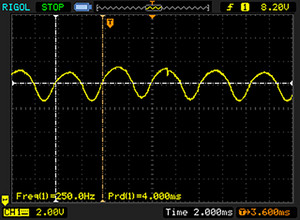 | |
| The brandish backlight flickers at 250 Hz (Probable utilizing PWM) . The frequency of 250 Hz is relatively depression, so sensitive users will likely notice flickering and feel eyestrain at the stated brightness setting and below. In comparison: 52 % of all tested devices do not use PWM to dim the display. If PWM was detected, an boilerplate of 22422 (minimum: 5 - maximum: 3846000) Hz was measured. | |||
OLED screens provide excellent contrasts and rich colors, which is also the case for the Samsung Galaxy S8 Plus. The panel has an adjustable mode, which automatically selects the right colour balance in compatible apps. The predefined profiles Simple, Photograph, and Cinema can likewise be selected manually. We checked the color accuracy of the different profiles with the spectrophotometer and the analysis software CalMAN. None of them shows real problems. The average DeltaE values are always below 3, which is the limit for visible deviations with the human center. Only the iPhone 7 Plus shows more accurate colors, simply information technology features a smaller color gamut in render.
The individual profiles differ quite a lot. Simple only covers sRGB and is less saturated, so the content looks pretty natural. Photo is a good fit for viewing pictures. It has a slightly warmer white balance and uses a reduced AdobeRGB gamut. Cinema almost covers the full P3 gamut completely and also provides the most accurate colors.
Display Response Times
ℹ
Display response times testify how fast the screen is able to change from one color to the next. Slow response times can lead to afterimages and can cause moving objects to announced blurry (ghosting). Gamers of fast-paced 3D titles should pay special attention to fast response times.
| ↔ Response Time Black to White | ||
|---|---|---|
| 3.two ms ... rise ↗ and fall ↘ combined | ↗ ii ms rise | 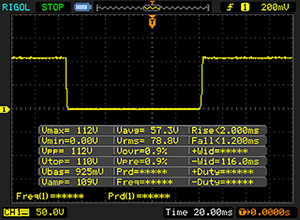 |
| ↘ 1.2 ms fall | ||
| The screen shows very fast response rates in our tests and should exist very well suited for fast-paced gaming. In comparison, all tested devices range from 0.8 (minimum) to 240 (maximum) ms. » 3 % of all devices are better. This means that the measured response time is better than the boilerplate of all tested devices (23.vii ms). | ||
| ↔ Response Fourth dimension fifty% Greyness to lxxx% Greyness | ||
| 5.half dozen ms ... rise ↗ and fall ↘ combined | ↗ two.eight ms rise | 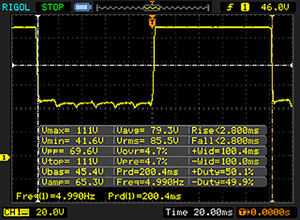 |
| ↘ ii.8 ms fall | ||
| The screen shows very fast response rates in our tests and should be very well suited for fast-paced gaming. In comparison, all tested devices range from 0.777 (minimum) to 636 (maximum) ms. » vi % of all devices are better. This ways that the measured response time is better than the average of all tested devices (37.five ms). | ||
The Samsung Galaxy S8 Plus leaves a slap-up impression outdoors. The high contrast ratio and the enormous luminance ensure excellent visibility, even nether straight sunlight. There are insufficiently few reflections on the panel, which is a real advantage outdoors.
Samsung improved the viewing-angle stability of the Galaxy S8 Plus significantly compared to the previous model. The slight color hue, which is typical for OLED screens, is only visible at very flat viewing angles starting at around 100 degrees. Information technology is combined with a slight brightness drop. Ghosting, glow, or clouding effects on the other hand are no problem for the Infinity display of the Galaxy S8+.
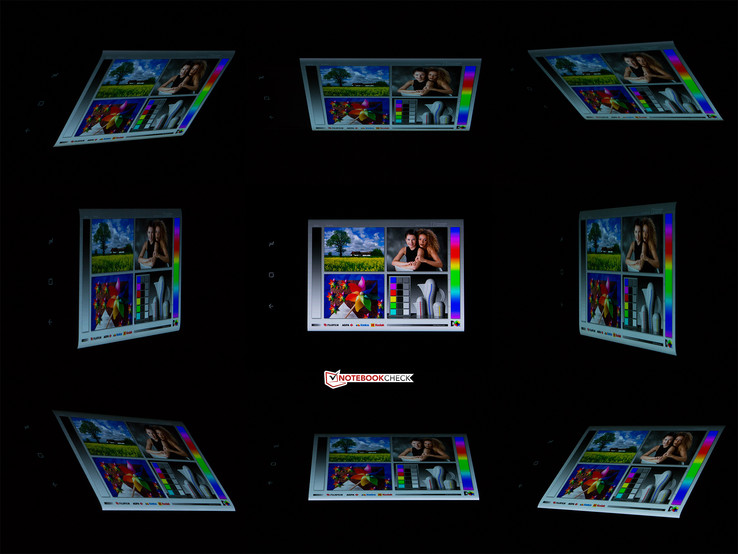
Samsung uses its own Exynos 9 chip for the European version of the Galaxy S8+ (SM-G955F), while U.Southward. models (amidst others) are equipped with the Qualcomm Snapdragon 835. The Exynos 8895 is ane of the first 10-nm SoCs and is supposed to be more powerful besides as more than efficient than its predecessor 8890. Samsung speaks about 27% more performance and 40% less power consumption. The manufacturer in one case over again uses a big.LITTLE architecture with ii clusters consisting of four cores each. The performance cluster uses Samsung's custom M1 CPU cores (2nd generation) clocked at up to 2.3 GHz. The efficient cluster on the other paw uses ARM Cortex-A53 cores clocked at up to ane.7 GHz. Samsung uses the ARM Mali-G71 GPU, which is as well used past Huawei'due south Mate 9. However, the Korean version does not use only eight GPU cores for graphics calculations, it uses twenty. The high-performance SoC is supported by iv GB LPDDR4x retention.
The criterion results of the Samsung Milky way S8 Plus are very good, and it tin set new records in some benchmarks. It beats the previous leaders Mate 9 and iPhone 7 Plus by thirteen% in Geekbench 4 Multi. However, the Apple smartphone is still at the pinnacle when you but stress one cadre. The test model is likewise very good in the GPU benchmarks, and it beats the iPhone every bit well equally all the other rivals in the powerful benchmarks. The high screen resolution of the Galaxy S8+, even so, tin can affect the scores in the onscreen benchmarks.
The Milky way S8 Plus sometimes falls behind the rivals in the system benchmarks. It is slap-up in AnTuTu, but the Xperia XZ, Mate 9, and Moto Z perform better in PCMark. Subjectively, the system performance is very smooth though.
| AnTuTu v6 - Total Score (sort past value) | |
| Samsung Milky way S8 Plus | |
| Samsung Milky way S7 Edge | |
| Sony Xperia XZ | |
| HTC U Ultra | |
| LG G6 | |
| Google Pixel Xl 2016 | |
| Lenovo Moto Z | |
| Huawei Mate nine | |
| Apple iPhone 7 Plus | |
| Geekbench four.ane - 4.4 | |
| 64 Scrap Single-Cadre Score (sort by value) | |
| Samsung Galaxy S8 Plus | |
| LG G6 | |
| Huawei Mate 9 | |
| 64 Bit Multi-Core Score (sort by value) | |
| Samsung Galaxy S8 Plus | |
| LG G6 | |
| Huawei Mate 9 | |
| Geekbench 4.0 | |
| 64 Bit Single-Core Score (sort past value) | |
| Samsung Galaxy S8 Plus | |
| Samsung Milky way S7 Edge | |
| Sony Xperia XZ | |
| HTC U Ultra | |
| Google Pixel 40 2016 | |
| Lenovo Moto Z | |
| Huawei Mate 9 | |
| Apple iPhone 7 Plus | |
| 64 Bit Multi-Core Score (sort by value) | |
| Samsung Galaxy S8 Plus | |
| Samsung Galaxy S7 Edge | |
| Sony Xperia XZ | |
| HTC U Ultra | |
| Google Pixel 40 2016 | |
| Lenovo Moto Z | |
| Huawei Mate 9 | |
| Apple tree iPhone 7 Plus | |
| Basemark ES 3.one / Metal - offscreen Overall Score (sort by value) | |
| Samsung Milky way S8 Plus | |
| Samsung Galaxy S7 Edge | |
| LG G6 | |
| Google Pixel 40 2016 | |
| Lenovo Moto Z | |
| Huawei Mate 9 | |
| Apple iPhone seven Plus | |
| 3DMark | |
| 2560x1440 Sling Shot OpenGL ES iii.0 Unlimited (sort by value) | |
| Samsung Milky way S8 Plus | |
| Samsung Milky way S7 Edge | |
| Sony Xperia XZ | |
| HTC U Ultra | |
| LG G6 | |
| Google Pixel 40 2016 | |
| Lenovo Moto Z | |
| Huawei Mate 9 | |
| Apple iPhone 7 Plus | |
| 2560x1440 Sling Shot OpenGL ES 3.0 Unlimited Graphics (sort past value) | |
| Samsung Galaxy S8 Plus | |
| Samsung Galaxy S7 Edge | |
| Sony Xperia XZ | |
| HTC U Ultra | |
| LG G6 | |
| Google Pixel XL 2016 | |
| Lenovo Moto Z | |
| Huawei Mate ix | |
| Apple iPhone 7 Plus | |
| 2560x1440 Sling Shot OpenGL ES 3.0 Unlimited Physics (sort by value) | |
| Samsung Galaxy S8 Plus | |
| Samsung Milky way S7 Border | |
| Sony Xperia XZ | |
| HTC U Ultra | |
| LG G6 | |
| Google Pixel XL 2016 | |
| Lenovo Moto Z | |
| Huawei Mate 9 | |
| Apple tree iPhone 7 Plus | |
| 2560x1440 Sling Shot Farthermost (ES 3.1) Unlimited (sort past value) | |
| Samsung Galaxy S8 Plus | |
| Samsung Milky way S7 Edge | |
| Sony Xperia XZ | |
| HTC U Ultra | |
| LG G6 | |
| Google Pixel 40 2016 | |
| Lenovo Moto Z | |
| Huawei Mate 9 | |
| 2560x1440 Sling Shot Extreme (ES 3.one) Unlimited Graphics (sort by value) | |
| Samsung Galaxy S8 Plus | |
| Samsung Milky way S7 Edge | |
| Sony Xperia XZ | |
| HTC U Ultra | |
| LG G6 | |
| Google Pixel 40 2016 | |
| Lenovo Moto Z | |
| Huawei Mate nine | |
| 2560x1440 Sling Shot Extreme (ES 3.1) Unlimited Physics (sort by value) | |
| Samsung Galaxy S8 Plus | |
| Samsung Milky way S7 Edge | |
| Sony Xperia XZ | |
| HTC U Ultra | |
| LG G6 | |
| Google Pixel XL 2016 | |
| Lenovo Moto Z | |
| Huawei Mate 9 | |
| GFXBench (DX / GLBenchmark) ii.seven | |
| T-Rex Onscreen (sort by value) | |
| Samsung Milky way S8 Plus | |
| Samsung Galaxy S7 Edge | |
| Sony Xperia XZ | |
| HTC U Ultra | |
| LG G6 | |
| Google Pixel XL 2016 | |
| Lenovo Moto Z | |
| Huawei Mate 9 | |
| Apple iPhone vii Plus | |
| 1920x1080 T-Rex Offscreen (sort by value) | |
| Samsung Galaxy S8 Plus | |
| Samsung Milky way S7 Border | |
| Sony Xperia XZ | |
| HTC U Ultra | |
| LG G6 | |
| Google Pixel Forty 2016 | |
| Lenovo Moto Z | |
| Huawei Mate 9 | |
| Apple iPhone 7 Plus | |
| GFXBench 3.0 | |
| on screen Manhattan Onscreen OGL (sort by value) | |
| Samsung Galaxy S8 Plus | |
| Samsung Galaxy S7 Edge | |
| Sony Xperia XZ | |
| HTC U Ultra | |
| LG G6 | |
| Google Pixel Twoscore 2016 | |
| Lenovo Moto Z | |
| Huawei Mate 9 | |
| Apple iPhone 7 Plus | |
| 1920x1080 1080p Manhattan Offscreen (sort by value) | |
| Samsung Galaxy S8 Plus | |
| Samsung Galaxy S7 Edge | |
| Sony Xperia XZ | |
| HTC U Ultra | |
| LG G6 | |
| Google Pixel 40 2016 | |
| Lenovo Moto Z | |
| Huawei Mate nine | |
| Apple iPhone vii Plus | |
| GFXBench 3.1 | |
| on screen Manhattan ES 3.1 Onscreen (sort past value) | |
| Samsung Galaxy S8 Plus | |
| Samsung Galaxy S7 Border | |
| Sony Xperia XZ | |
| HTC U Ultra | |
| LG G6 | |
| Google Pixel Xl 2016 | |
| Lenovo Moto Z | |
| Huawei Mate 9 | |
| Apple tree iPhone 7 Plus | |
| 1920x1080 Manhattan ES 3.1 Offscreen (sort by value) | |
| Samsung Galaxy S8 Plus | |
| Samsung Galaxy S7 Edge | |
| Sony Xperia XZ | |
| HTC U Ultra | |
| LG G6 | |
| Google Pixel XL 2016 | |
| Lenovo Moto Z | |
| Huawei Mate 9 | |
| Apple tree iPhone 7 Plus | |
| GFXBench | |
| on screen Car Hunt Onscreen (sort by value) | |
| Samsung Galaxy S8 Plus | |
| Samsung Galaxy S7 Edge | |
| Sony Xperia XZ | |
| HTC U Ultra | |
| LG G6 | |
| Google Pixel XL 2016 | |
| Lenovo Moto Z | |
| Huawei Mate 9 | |
| 1920x1080 Car Chase Offscreen (sort by value) | |
| Samsung Galaxy S8 Plus | |
| Samsung Galaxy S7 Edge | |
| Sony Xperia XZ | |
| HTC U Ultra | |
| LG G6 | |
| Google Pixel XL 2016 | |
| Lenovo Moto Z | |
| Huawei Mate nine | |
| PCMark for Android | |
| Work performance score (sort by value) | |
| Samsung Galaxy S8 Plus | |
| Samsung Milky way S7 Edge | |
| Sony Xperia XZ | |
| HTC U Ultra | |
| LG G6 | |
| Google Pixel XL 2016 | |
| Lenovo Moto Z | |
| Huawei Mate 9 | |
| Work two.0 performance score (sort by value) | |
| Samsung Milky way S8 Plus | |
| Sony Xperia XZ | |
| HTC U Ultra | |
| LG G6 | |
| Huawei Mate 9 | |
| BaseMark OS II | |
| Overall (sort past value) | |
| Samsung Milky way S8 Plus | |
| Samsung Milky way S7 Edge | |
| Sony Xperia XZ | |
| HTC U Ultra | |
| LG G6 | |
| Google Pixel Xl 2016 | |
| Lenovo Moto Z | |
| Huawei Mate 9 | |
| Apple iPhone 7 Plus | |
| Organisation (sort by value) | |
| Samsung Galaxy S8 Plus | |
| Samsung Galaxy S7 Edge | |
| Sony Xperia XZ | |
| HTC U Ultra | |
| LG G6 | |
| Google Pixel Twoscore 2016 | |
| Lenovo Moto Z | |
| Huawei Mate 9 | |
| Apple tree iPhone 7 Plus | |
| Memory (sort by value) | |
| Samsung Galaxy S8 Plus | |
| Samsung Galaxy S7 Edge | |
| Sony Xperia XZ | |
| HTC U Ultra | |
| LG G6 | |
| Google Pixel Forty 2016 | |
| Lenovo Moto Z | |
| Huawei Mate ix | |
| Apple iPhone 7 Plus | |
| Graphics (sort by value) | |
| Samsung Galaxy S8 Plus | |
| Samsung Galaxy S7 Edge | |
| Sony Xperia XZ | |
| HTC U Ultra | |
| LG G6 | |
| Google Pixel XL 2016 | |
| Lenovo Moto Z | |
| Huawei Mate ix | |
| Apple iPhone 7 Plus | |
| Web (sort by value) | |
| Samsung Milky way S8 Plus | |
| Samsung Galaxy S7 Edge | |
| Sony Xperia XZ | |
| HTC U Ultra | |
| LG G6 | |
| Google Pixel Twoscore 2016 | |
| Lenovo Moto Z | |
| Huawei Mate 9 | |
| Apple iPhone vii Plus | |
| Lightmark - 1920x1080 1080p (sort by value) | |
| Samsung Milky way S8 Plus | |
| Samsung Galaxy S7 Edge | |
| LG G6 | |
| Lenovo Moto Z | |
| Huawei Mate 9 | |
| PassMark PerformanceTest Mobile V1 | |
| System (sort past value) | |
| Samsung Galaxy S8 Plus | |
| Samsung Milky way S7 Edge | |
| Google Pixel Xl 2016 | |
| Lenovo Moto Z | |
| Huawei Mate 9 | |
| Apple tree iPhone 7 Plus | |
| CPU Tests (sort by value) | |
| Samsung Galaxy S8 Plus | |
| Samsung Galaxy S7 Edge | |
| Google Pixel XL 2016 | |
| Lenovo Moto Z | |
| Huawei Mate 9 | |
| Apple iPhone vii Plus | |
| Disk Tests (sort by value) | |
| Samsung Galaxy S8 Plus | |
| Samsung Galaxy S7 Edge | |
| Google Pixel Xl 2016 | |
| Lenovo Moto Z | |
| Huawei Mate 9 | |
| Apple tree iPhone seven Plus | |
| Retention Tests (sort past value) | |
| Samsung Galaxy S8 Plus | |
| Samsung Galaxy S7 Edge | |
| Google Pixel Twoscore 2016 | |
| Lenovo Moto Z | |
| Huawei Mate nine | |
| Apple iPhone seven Plus | |
| 2D Graphics Tests (sort past value) | |
| Samsung Galaxy S8 Plus | |
| Samsung Galaxy S7 Edge | |
| Google Pixel XL 2016 | |
| Lenovo Moto Z | |
| Huawei Mate 9 | |
| Apple tree iPhone 7 Plus | |
| 3D Graphics Tests (sort by value) | |
| Samsung Galaxy S8 Plus | |
| Samsung Milky way S7 Edge | |
| Google Pixel Forty 2016 | |
| Lenovo Moto Z | |
| Huawei Mate ix | |
| Apple tree iPhone 7 Plus | |
Fable
Sony Xperia XZ Qualcomm Snapdragon 820 MSM8996, Qualcomm Adreno 530, 32 GB eMMC Wink
HTC U Ultra Qualcomm Snapdragon 821 MSM8996 Pro, Qualcomm Adreno 530, 64 GB eMMC Flash
LG G6 Qualcomm Snapdragon 821 MSM8996 Pro, Qualcomm Adreno 530, 32 GB UFS 2.0 Wink
Lenovo Moto Z Qualcomm Snapdragon 820 MSM8996, Qualcomm Adreno 530, 32 GB eMMC Wink
Huawei Mate ix HiSilicon Kirin 960, ARM Mali-G71 MP8, 64 GB UFS 2.1 Flash
The default browser is Samsung's own solution in version 5.two, which is much faster than Google Chrome 57 in a directly comparison. Chrome manages 3725 points in the criterion suite Vellamo iii, Android WebView 6640 points and Samsung's browser 7466 points. The Galaxy S8 Plus is also really fast within the comparison grouping, only it cannot keep up with the iPhone 7 Plus. Subjectively, spider web-browsing is a very smooth experience.
The Samsung Galaxy S8 Plus is equipped with 64 GB UFS 2.1 wink storage; the bigger 128 GB model seems to be reserved for the Asian market right at present. The Mate 9 is currently the only comparing device with this fast storage type, but the Galaxy smartphone is even faster in Androbench, peculiarly in terms of read and write functioning. This changes in the corresponding Passmark and Basemark tests, where the Mate nine is ahead.
You can utilize effectually 52.3 GB afterward the initial setup of the smartphone. The operating system occupies a lot of space (11.7 GB). Nosotros checked the operation of the SD-carte reader with our reference card Toshiba Exceria Pro M401 (read: up to 95 MB/due south, write upward to fourscore MB/s). The results are on par with the Galaxy S7 Edge, which is insufficiently fast, only it cannot apply the full potential of the card.
| Samsung Galaxy S8 Plus | Samsung Milky way S7 Edge | Sony Xperia XZ | HTC U Ultra | Google Pixel XL 2016 | Lenovo Moto Z | Huawei Mate 9 | Apple iPhone 7 Plus | |
|---|---|---|---|---|---|---|---|---|
| AndroBench 3-v | -16% | -45% | -12% | -40% | 53% | -32% | ||
| Sequential Read 256KB | 787.six | 487.34 -38% | 281 -64% | 423.9 -46% | 258.23 -67% | 439.66 -44% | 594.23 -25% | |
| Sequential Write 256KB | 194.xviii | 145.11 -25% | 138 -29% | 164.7 -15% | 83.38 -57% | 168.32 -13% | 142.92 -26% | |
| Random Read 4KB | 127.18 | 86.71 -32% | 71.5 -44% | 84.2 -34% | 87.67 -31% | 117.15 -8% | 94.69 -26% | |
| Random Write 4KB | fifteen.27 | 15.79 3% | 10.five -31% | 13.7 -10% | fourteen.56 -5% | 74.93 391% | 8.77 -43% | |
| Sequential Read 256KB SDCard | 71.12 | 76.43 7% | 33.5 -53% | 82.8 sixteen% | 78.51 10% | 53.97 -24% | ||
| Sequential Write 256KB SDCard | 57.24 | l.36 -12% | 29.8 -48% | 67.6 18% | 45.64 -twenty% | 29.53 -48% | ||
| PassMark PerformanceTest Mobile V1 | -50% | -27% | -xviii% | 38% | 55% | |||
| Disk Tests | 92548 | 36364 -61% | 44706 -52% | 68378 -26% | 117939 27% | 48907 -47% | ||
| Memory Tests | 9844 | 6136 -38% | 9673 -two% | 8912 -9% | 14580 48% | 25299 157% | ||
| BaseMark OS Ii | ||||||||
| Retentivity | 3135 | 2072 -34% | 1434 -54% | 1581 -50% | 1677 -47% | 2190 -30% | 3850 23% | 1319 -58% |
| Total Average (Plan / Settings) | -33% / -26% | -l% / -46% | -31% / -17% | -38% / -37% | two% / 28% | ten% / -10% | -2% / 17% |
Gaming is a great experience on the Samsung Milky way S8 Plus thank you to the combination of bully display and powerful hardware. The ARM Mali-G71 MP20 is significantly faster than the Adreno 530 inside many other high-end smartphones. It will nearly probable compete with the successor Adreno 540, merely the Mali is the fastest GPU in an Android smartphone at the time of writing. It likewise supports all mod APIs, including Vulkan 1.0, which is already supported by a couple of games similar Demand for Speed: No Limits or Hit.
The Game Launcher is already familiar from the previous model and is one time over again included. This is additional value for gamers, considering they can easily have videos or screenshots when they play without getting annoying notifications. There is no criticism for the touchscreen and the sensors. Only the position of the speaker is still not perfect, because you will quickly cover it in landscape mode. Games are adjusted to the 16:9 screen ratio, and so you get thick bezels in landscape mode, simply the treatment of the Galaxy is still good in return, despite the slim frame.
| Cobblestone 8: Airborne | |||
| Settings | Value | ||
| high | 30 fps | ||
| very depression | thirty fps | ||
| Dead Trigger 2 | |||
| Settings | Value | ||
| high | 30 fps | ||
The surfaces of the Samsung galaxy S8 Plus hardly warm up while idling and the device only gets lukewarm under sustained workloads at up to 36 °C. The situation is not as relaxed inside the instance. Nosotros tested the behavior of the SoC with the GFXBench bombardment tests.
The smartphone can maintain its performance for quite a while in the T-King exam, which is based on the older OpenGL ES 2.0 interface. The functioning drops afterward 17 runs, only we tin can only see throttling after the 22nd run, where the Galaxy S8+ loses 21% of its original performance. The more than demanding Manhattan test with OpenGL ES 3.ane is a bigger challenge. The functioning drops by fifteen% afterward three runs and past a total of 42% after xviii runs. However, the frame rate (855) is withal much higher compared to the Galaxy A5 (Exynos 7880, up to 561 FPS).
The test model does not accept to hide behind the Galaxy S7 Border, either, because the functioning stability is like and the stop result is still pretty good. The reward over the previous model is ~700 frames in the T-Rex test, which is about 50% of the maximum performance on a cold A5.
| |||||||||||||||||||||||||
| Maximum: 35.7 °C = 96 F Boilerplate: 34.vii °C = 94 F | |||||||||||||||||||||||||
| |||||||||||||||||||||||||
| Maximum: 36 °C = 97 F Boilerplate: 33.5 °C = 92 F | |||||||||||||||||||||||||
Ability Supply (max.) 30.1 °C = 86 F | Room Temperature 21.3 °C = 70 F | Voltcraft IR-260
| |||||||||||||||||||||||||
| Maximum: 28.8 °C = 84 F Boilerplate: 28 °C = 82 F | |||||||||||||||||||||||||
| |||||||||||||||||||||||||
| Maximum: 27.vii °C = 82 F Boilerplate: 27.3 °C = 81 F | |||||||||||||||||||||||||
Power Supply (max.) 29 °C = 84 F | Room Temperature 21.iii °C = lxx F | Voltcraft IR-260
(±) The boilerplate temperature for the upper side under maximal load is 34.7 °C / 94 F, compared to the boilerplate of 32.8 °C / 91 F for the devices in the class Smartphone.
(+) The maximum temperature on the upper side is 35.7 °C / 96 F, compared to the average of 35.1 °C / 95 F, ranging from 22 to 52.9 °C for the class Smartphone.
(+) The bottom heats up to a maximum of 36 °C / 97 F, compared to the average of 33.8 °C / 93 F
(+) In idle usage, the average temperature for the upper side is 28 °C / 82 F, compared to the device average of 32.8 °C / 91 F.
The mono speaker of the Samsung Galaxy S8 Plus is once again located at the lesser of the smartphone and the audio is very similar to the predecessor. The module is quite loud at up to 83 dB(A). Most of the lower frequencies are not aural and but the upper office is noticeable when information technology is not drowned out by the mids and high tones. The mids are pretty linear, but there is too much emphasis on the high tones, and so the overall audio feel is not really counterbalanced. The quality is sufficient for occasional video or music playback, only you should use headphones or external solutions for better quality.
The provided AKG headset is already a decent alternative. It sounds proficient and covers lower and medium frequencies much better equally long equally you do not creepo the volume up. The high tones volition otherwise distort, which can sound strange for some pitches. The output via 3.5 mm jack on the other hand is subjectively dissonance-free and dynamic.
We likewise tested the connection via Bluetooth 5.0. Nevertheless, we did not have a corresponding speaker that supports this standard, and so we cannot test the range. The playback via Bluetooth 4.0 speaker on the other hand was no problem. Bluetooth 5.0 also supports aptX for streaming in CD quality. The newer aptX HD standard, withal, is non supported. The simultaneous connection with 2 unlike Bluetooth speakers was no problem, either, and both components used dissimilar standards (BT iv.0 & BT 4.2).
Samsung Milky way S8 Plus audio analysis
(+) | speakers tin play relatively loud (82.88 dB)
Bass 100 - 315 Hz
(-) | well-nigh no bass - on average 21.5% lower than median
(±) | linearity of bass is boilerplate (12% delta to prev. frequency)
Mids 400 - 2000 Hz
(±) | higher mids - on average five.2% higher than median
(+) | mids are linear (3.8% delta to prev. frequency)
Highs 2 - 16 kHz
(±) | higher highs - on average five.two% higher than median
(±) | linearity of highs is average (vii.7% delta to prev. frequency)
Overall 100 - 16.000 Hz
(±) | linearity of overall sound is average (21.8% difference to median)
Compared to aforementioned grade
» 36% of all tested devices in this class were better, 11% like, 53% worse
» The best had a delta of 12%, average was 23%, worst was 65%
Compared to all devices tested
» 60% of all tested devices were better, 8% similar, 33% worse
» The best had a delta of 3%, boilerplate was 20%, worst was 65%
Apple iPhone 7 Plus audio assay
(±) | speaker loudness is average but skillful (81.45 dB)
Bass 100 - 315 Hz
(-) | about no bass - on average 24.ane% lower than median
(±) | linearity of bass is average (7.iv% delta to prev. frequency)
Mids 400 - 2000 Hz
(+) | balanced mids - simply four.7% away from median
(±) | linearity of mids is average (seven.half-dozen% delta to prev. frequency)
Highs ii - 16 kHz
(+) | balanced highs - but 4.3% abroad from median
(+) | highs are linear (half dozen.ix% delta to prev. frequency)
Overall 100 - 16.000 Hz
(±) | linearity of overall sound is average (21.1% divergence to median)
Compared to same class
» 30% of all tested devices in this class were better, 11% similar, 59% worse
» The best had a delta of 12%, average was 23%, worst was 65%
Compared to all devices tested
» 55% of all tested devices were ameliorate, viii% similar, 37% worse
» The best had a delta of 3%, boilerplate was 20%, worst was 65%
Teufel Boomster audio analysis
(+) | speakers tin can play relatively loud (93.52 dB)
Bass 100 - 315 Hz
(+) | good bass - merely three.1% abroad from median
(+) | bass is linear (three.ane% delta to prev. frequency)
Mids 400 - 2000 Hz
(+) | balanced mids - only i.5% away from median
(+) | mids are linear (ane.4% delta to prev. frequency)
Highs 2 - xvi kHz
(+) | counterbalanced highs - only iv.6% away from median
(+) | highs are linear (3.7% delta to prev. frequency)
Overall 100 - 16.000 Hz
(+) | overall sound is linear (6% difference to median)
Compared to aforementioned form
» 2% of all tested devices in this class were ameliorate, 1% similar, 97% worse
» The best had a delta of three%, boilerplate was 18%, worst was 41%
Compared to all devices tested
» 0% of all tested devices were better, 0% like, 100% worse
» The best had a delta of 3%, average was 20%, worst was 65%
Frequency comparison (checkboxes are selectable/deselectable!)
Samsung was able to reduce the ability consumption of the Milky way S8 Plus compared to its predecessor, despite the bigger panel, and merely the Pixel Forty can keep up while idling. Nosotros performed the measurements at the highest luminance with the deactivated light sensor. In one case it is running and the luminance is at the maximum, nosotros can see a meaning increase by 0.62 Watts. The ability consumption under load is a bit conspicuous in full general, because it seems to be regulated by the system since we could non measure more than five.28 Watts in the Stability Exam. Yet, we measured upward to ix.56 Watts during the kick sequence.
The Always-On brandish is pretty efficient. The smartphone only consumes 0.13 Watts during standby and 0.23 Watts (on average) with the Always-On display.
The power consumption of the power adapter is exemplary, considering it only draws 0.0001 Watt from the socket. It supports Fast Charging and only needs 111 minutes to recharge the Galaxy S8+. The bombardment charge was at 9% afterward 15 minutes; 22% after 30 minutes. The 50% marking is reached later 52 minutes, and 80% later 76 minutes. It is also possible to charge the Galaxy S8 Plus wirelessly.
The battery capacity of the Samsung galaxy S8 Plus is a bit smaller compared to the previous S7 Edge (3600 mAh) at 3500 mAh. The runtimes are on par in full general, only the S7 Edge had more stamina during video playback.
The tests at an adjusted luminance of 150 nits are the best style to compare different devices, and the tests were performed at the highest display resolution. The Galaxy S8 Plus performs very well and reaches groovy runtimes. Nosotros also ran the PCMark Bombardment Test at this setting and we can once again run across a good runtime, which almost keeps up with the Mate 9 and clearly beats the predecessor.
Samsung too offers some features to relieve ability. This includes the familiar Ultra-Powersaver mode likewise as other predefined settings, which reduce the power consumption past limiting the console resolution and the CPU performance.
Bombardment Runtime
| Idle (without WLAN, min effulgence) | 26h 05min | |
| WiFi Websurfing | 12h 16min | |
| Big Buck Bunny H.264 1080p | 12h 22min | |
| Load (maximum brightness) | 4h 35min |
Pros
+ great display
+ nice design
+ fast SoC
+ very proficient GPS performance
+ fast Wi-Fi
+ Gigabit LTE
+ good voice quality
+ comprehensive sensor equipment
+ USB 3.1 with DP, HDMI, and OTG
+ long battery runtime
+ Quick-charge and wireless charging
+ water and grit-proof
+ very skilful camera…
Cons
- …but unfortunately not much improved over the predecessor
- no dual-SIM
- could support more than LTE bands
- bad position of the fingerprint scanner
- SoC throttling under sustained workloads
- warranty does not comprehend water harm
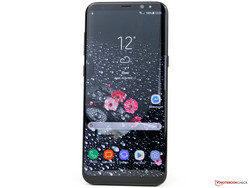
Samsung's Milky way S8 Plus is an fantabulous smartphone, which does non reveal whatsoever serious weaknesses. The new and nigh bezel-less design already looks cracking on pictures, but it is even more than impressive when you agree it in the hand. The Infinity brandish convinces in all respects: colour accuracy, luminance and reflectiveness. However, the performance of the new Samsung Exynos 8895 is also excellent and can even keep up with Apple tree's A10 chip.
The connectivity of the Milky way S8 Plus does not deserve whatsoever criticism, either. The voice quality is good, and yous get very fast Wi-Fi besides every bit Gigabit LTE. The latter could comprehend more than frequencies though, and you might get problems if you travel a lot in North America or Asia. The local restrictions by the manufacturer are annoying, and in that location is no dual-SIM model in Europe, either.
The Samsung Galaxy S8+ offers many high-end features, a really good camera, and cracking runtimes. There is not much criticism for the smartphone after our review.
We would like to meet more choices for customers in general. The 128 GB version will not exist bachelor in Europe, which is also the case for some of the colors.
Samsung also implements a lot of security features. Withal, you lot can hands beat the facial recognition, and so we do non recommend using it. The fingerprint scanner at the rear is likewise tricky to accomplish.
All in all, Samsung adult a great smartphone, which convinces by its bang-up blueprint, still has an outstanding photographic camera, very adept battery runtimes and a magnificent bezel-less display. Only the high premium over the smaller S8 model is quite loftier.
Samsung Galaxy S8 Plus - 2017-04-13 04/13/2017 v6(former)
Daniel Schmidt
Smartphone - Weighted Average
Pricecompare
Daniel Schmidt, 2017-06-13 (Update: 2019-04- 5)
Source: https://www.notebookcheck.net/Samsung-Galaxy-S8-Plus-SM-G955F-Smartphone-Review.213438.0.html


0 Response to "How Big of a Hd Can You Read With a Galaxy S8 Plus"
Publicar un comentario